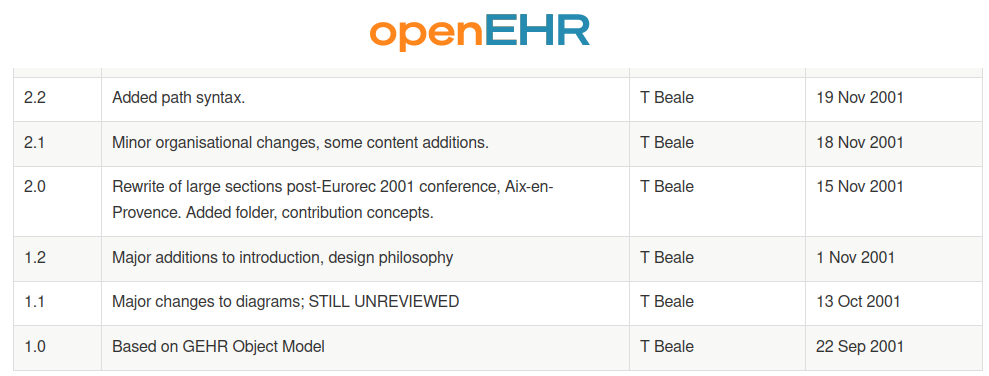
openEHR was officially created on 13 March 2003, 20 years ago today. Prof David Ingram thought of the name, and he and a small band of optimists – Dr Sam Heard, Dr Dipak Kalra, David Lloyd and myself – launched into building and open architecture for the electronic health record.
As you can see from the earliest entries from the Amendment History of the EHR Information Model specification, above, we had already been working on it for a couple of years. In reality we’d been working on things together since 1994, when I joined the GEHR project.
What have we achieved? Some surprising things. Some people look at openEHR, and they see information model specifications that are 20 years old (well, of course some are quite recent) and think: well that’s out of date, no-one would use 20 year old models in any industry!
Think again. Those information models, although incrementally modified over time by the usual process of validation in implementation, are largely the same as they were back then, and they are running today inside the products of dozens of companies, some listed here. None of the information model specifications have yet reached v2, i.e. we have not yet had to introduce any breaking changes.
Over the intervening years, many other engineers, clinical informaticians and clinical professionals have contributed to what we have built together. Pick any of the specifications as they are today and you’ll see a list like this:

One of the things we did in openEHR was to create a language for authoring clinical models, known as Archetypes. That allowed a clinical modelling community to spring up, and under the tutelage of Dr Heather Leslie, Dr Sam Heard, and later on, Dr Ian McNicoll, Silje Losland Bakke and others, they have created the largest open repository of computable clinical content models in the world. This is housed in the openEHR Clinical Knowledge Manager (CKM), a category-defining tool largely built by one brilliant clinical informatician, Sebastian Garde. It contains 800+ archetypes, around 8,000 clinical data points, 3,000 accounts, from over 100 countries.
Dr Heather Leslie particularly has poured her energies into openEHR’s huge repository, guiding modelling style and managing quality, and the results are there for all to see.
Did you like the contributor’s list above for the technical specs? Have a look at the contributors list for a typical archetype (problem/diagnosis):



Those clinicians and informaticists have been working on those models for 10 years. But they’re not just models. They are used to build ‘templates’ and also portable queries (in AQL) which can be used with live openEHR systems. No updates to backend software or DB needed. Today those models are being used by low-code programming environments to enable the creation of applications by business analysts, who understand healthcare, rather than programmers, who don’t. One of the early adopter companies, Better (Slovenia) has pioneered these kinds of tools, and proved that model-based engineering is a real thing (they also supply the free-to-use Archetype Designer used by openEHR community). Other companies are going down the same route.
It’s impossible to even mention all the magnificent efforts that have gone into this work – you’ll have to browse the openEHR website, CKM, the specifications site, the forums and the news site to see for yourself.
There is much more to do of course, and in the age of chatGPT, there are challenges to contemplate that we had not even thought of back at the start. But one thing we know: the problem of siloed healthcare data and non-interoperability remains nearly as bad as it was 20 years ago. We hope to have improved the equation just a little bit by our efforts.
If we have achieved one thing, I believe it is to have provided a way for workers from a domain (clinical medicine) to define the semantics and information of what they do, in a way that directly defines the IT solutions that they use. We on the engineering side just provide the pathway.
Work continues today on openEHR, with the development of REST APIs, JSON schemas, new specifications; new governments adopting the standard; and tech giants joining up (see the home page).
The 20th birthday of openEHR is a fitting date to highlight another exciting development: Prof David Ingram, one of the elder statesmen of health informatics education in the world, and the father of openEHR, is about to publish a book on computing in healthcare. It’s taken him 3 years to write and is an eclectic history of science, computing and medicine in one volume. You can read about it here, and if you want to contribute to the final publication step (crowd-funder) please do so. It is a history of the working lives of many of us.
My personal thanks to all the colleagues I have worked with over the years, and those in my personal life, particularly for enduring my unreasonableness. Although I like to think we’re all a bit unreasonable. Otherwise we wouldn’t be doing this. It’s been a real inspiration to work with some of the brightest minds around today. Thank you all.
London, 13 Mar 2023



Congratulations Thomas and all OpenEHR founders!
Congratulations, 20 years later it is becoming a de-facto standard!
All the original guys deserve a price for endurance, and for being channels to catalyze such a useful spec. About we using 20 years old model, I think it’s valid and current just because it’s more than a model, it’s a set of good patterns for clinical data. It’s like design patterns book for OOP published in 1994, patterns are current and will always be, because are focused on solving a generic problem. Also using patterns for information models allow data based on those models to live longer, which in healthcare is a requirement, and something openEHR does very well. We are standing on the shoulders of giants. Thanks again to all these crazy guys that allowed us to be crazy too 🙂